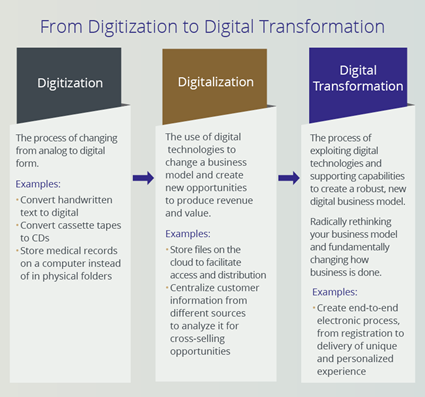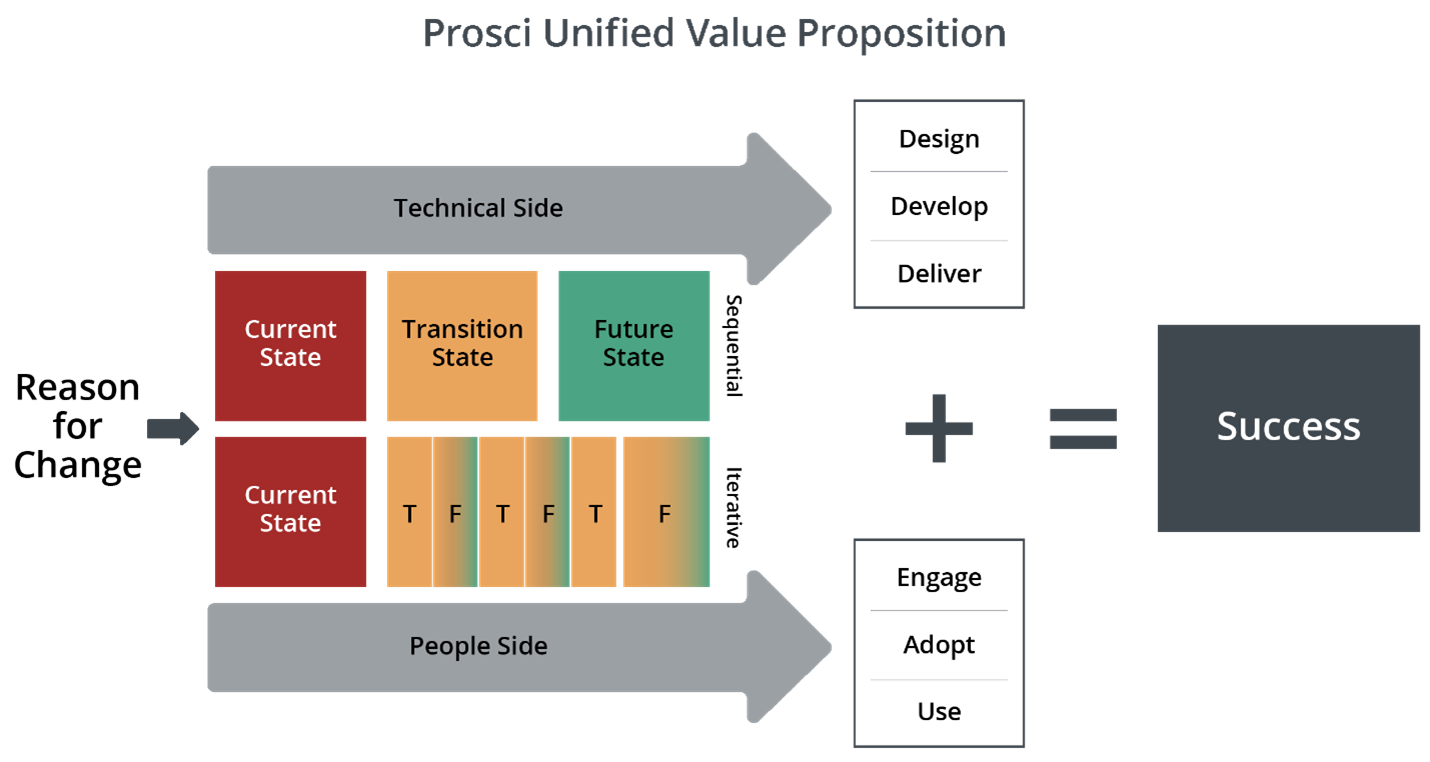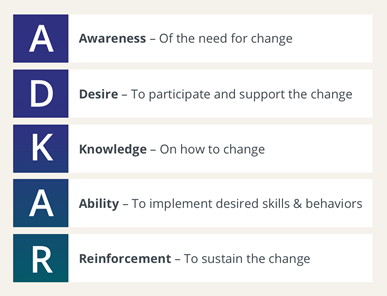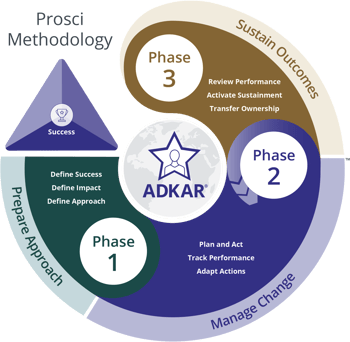This blog was originally published on www.prosci.com
Over the past decade, organisations have consistently identified digital transformation as a top priority to gain and maintain competitive advantage. The COVID-19 pandemic accelerated the speed of change, making what was unthinkable in 2019 (like entire organisations working remotely) the norm.
Yet, despite the attention and prominence digital transformation is getting in the business world, there is confusion as to what digital transformation is and what it entails. More importantly, organisations continue to struggle with adoption and usage of the technologies they have implemented because of that confusion. Change management—or the managing the people side of change—addresses this problem.
What is Digital Transformation?
At the start of the pandemic, Microsoft CEO Satya Nadella stated that the world saw two years' worth of digital transformation in just two months. “From remote teamwork and learning to sales and customer service to critical cloud infrastructure and security," he said, "we are working alongside customers every day to help them stay open for business in a world of remote everything.” Nadella's comment resonates with organisations because the digital transformation most of us experienced involved installing important technologies to enable full remote work capabilities very quickly. Unfortunately, many organisations focused only on one aspect of the digital transformation: the technology itself. If digital transformation involves more than installing technology, what does digital transformation actually mean?
- According to Stanford University, digital transformation is more than a minor modification to business processes. It’s transformational in that it’s about radically rethinking your business model and fundamentally changing how you do business.
- Salesforce defines digital transformation as the process of using digital technologies to create new or modify existing business processes, organisational culture and customer experiences to meet changing business and market requirements. The reimagining of business in the digital age is digital transformation.
- Gartner describes digital transformation as the process of exploiting digital technologies and supporting capabilities to create a robust new digital business model.
These definitions have an important element in common: digital transformation touches the entire organisation and the company business model. It comprises much more than technology because it requires a shift in the way people in the organisation work and, ultimately, a cultural change. This is what makes successful digital transformation tricky.
The difference between digitalization and digital transformation is that the former applies technology to existing business processes and workflows, while the latter is about repurposing these processes and workflows in a new digital way.
Download: Introduction to Change Management Guide

Digital transformation, digitisation and digitalisation
There is also confusion about the differences between digital transformation, digitisation and digitalisation. Often these terms are used interchangeably, but they mean different things—and it is not a matter of semantics.
The benefits linked to each vary significantly. Digitisation is the process of changing from analogue to digital format. It is the classic example of converting handwritten text into digital form. Unlike digital transformation, digitisation focuses on the information alone without changing the process, which simply becomes automated. Digitisation helps by increasing productivity and efficiency while decreasing costs.
Digitalisation leverages digital technologies to change a business model and create new revenue-producing and value-producing opportunities. In other words, it’s the process of moving to a digital business. With digitalisation, existing processes and business models are optimised thanks to the ability to leverage digital data in a specific way through technology. An example of digitalisation is uploading a PDF document (the handwritten text that was converted into digital form in the previous example) from a laptop’s hard drive to the cloud, so it can be shared with other teams in the organisation to enable them to analyse the data.
Digital transformation requires both digitisation and digitalisation. The key distinctive element is the transformation: how to create long-term competitive advantage to be successful and retain primacy in the market.

Digital transformation is not about digitising what companies already do or applying technology to the existing business such that they achieve the transformation (digitalisation). It is about redefining how they create value and how they differentiate themselves from the competition by providing unique and personalised customer experiences. Digital transformation is made possible by the increased pace of inventions and by how these new technologies are combined in ways that create new capabilities that exceed what could be possible when they are deployed separately.
"Digital transformation is an ongoing process of changing the way you do business. It requires foundational investments in skills, projects, infrastructure and, often, in cleaning up IT systems. It requires mixing people, machines and business processes, with all the messiness that it entails."
—Professor George F. Westerman, MIT Sloan School of Management
Key challenges in digital transformation
This confusion is where we often find the first of two major challenges in digital transformation. Many executives think that by focusing on digitisation or digitalisation, they are in fact doing digital transformation. Automating existing processes and workflows does contribute to cost reduction, but it does not radically transform the business model and how business is done. Hence, this is one of the reasons why organisations do not achieve the ROI they expect. They often envision that by implementing one or several digitisation projects, they will achieve digital transformation. That’s not enough. Digital transformation requires changes to the culture and practices within the organisation.
This point leads to the second challenge when it comes to digital transformation. Leaders tend to focus only on the technology. When I discuss digital transformation with clients, it is not unusual to hear that they concentrate mainly—or solely—on the importance of designing, developing and deploying new technology, such as artificial intelligence (AI), Internet of Things (IoT), robotics, 3D printing, and Block Chain. Technology is undoubtedly important, but it is only one side of the equation. Having state-of-the-art systems, software and platforms is not enough in itself to achieve a successful digital transformation.
Finally, success requires also focusing on the organisational changes required to leverage the opportunities that technology offers. To take advantage of the power of technology, companies need to support the individuals impacted by the change, so they can adopt and use the new technology, change their mindset, and adopt different critical behaviours required to deliver the new products, services and customer experiences. This means that leaders need to direct their attention to the people side of change.
Integrating change management and project management
The disciplines of change management and project management each have a role to play in digital transformations, but effectively integrating the two disciplines enables success of the project and ultimately its return on investment (ROI). Prosci's Unified Value Proposition illustrates how this works.

Typically, when dealing with what they think is digital transformation, organisation leaders focus on the technical side or designing, developing and delivering the solution (e.g., the new app or uploading files on the cloud). They often believe that because the technical side is in place, they will automatically see the significant improvements to the bottom line.
However, even if the solution is state of the art, it is not enough by itself. The company also needs to focus on the people side of change with a repeatable, scalable approach. Impacted employees need to be supported in their personal change journey when adopting the new way of work and in doing it proficiently. Specific focus must be put on the cultural change and on the customer-centric experience.
How to get started with change management
The Prosci Methodology enables organisations to manage change successfully by supporting the impacted employees in their ADKAR journeys and by facilitating the organisational change through the Prosci 3-Phase Process.

When starting a digital transformation, it’s best to incorporate change management during the planning stages. If your project is in progress or fully implemented, change management can still help. Here's what you can do next to gain momentum with the people side of change and achieve quick wins.
1. Assess whether your organisation is focusing on digitisation, digitalisation or digital transformation, and whether the focus is the true intent of the executives
If you realise there is a mismatch between the organisation’s leaders understanding of these concepts and what they entail, aim at educating the organisation and showing the consequences of incorrectly applying these concepts. Support the leaders in reassessing their objectives and expectations.
2. Determine if the organisation is focusing only or mainly on the technical side of change
If this is the situation you are in, prepare a solid case for change management explaining why the people side of change is key when implementing digital transformation successfully. It is not only about technology—it is also about the people.
3. Integrate project management and change management
It is important to focus on how to support impacted individuals in adopting and using the technology, and how to change their mindset and critical behaviours linked to the new customer experience offered by the organisation they operate in.

Digital transformation and change management
It is critical to understand the differences between digital transformation, digitisation and digitalisation. It’s not only about semantics, but also about setting the correct strategy and expectations linked to these initiatives. Successful digital transformations require focus on both the technology and the people impacted by the change initiative.
By leveraging effective change management principles, you support individuals through the change process and enable them to adopt and use the technologies and other changes to their daily work. The result is a successful digital transformation with greater adoption and usage, increased project ROI, and a positive shift in organisational culture.
This blog was originally published on www.prosci.com



